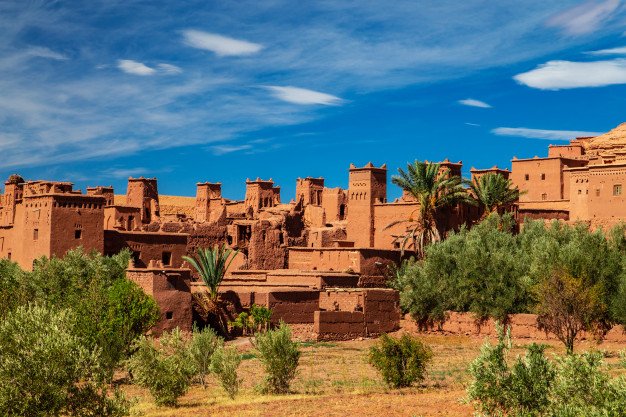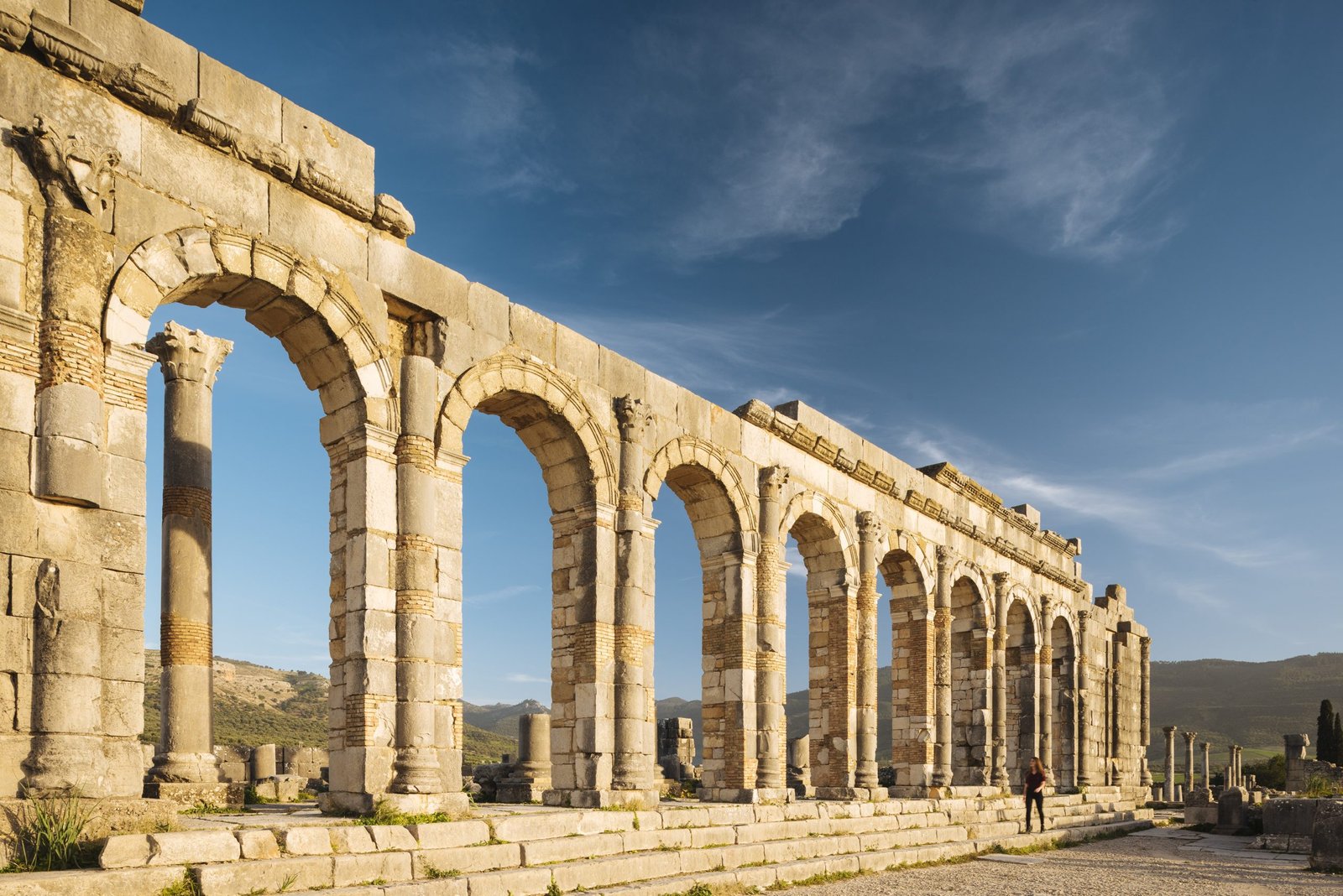1. Moroccan Ancient Sites: Volubilis
If you are eager to discover some ancient Moroccan sites, Volubilis is a fascinating place to go as it is an ancient Roman ruins in Morocco. Volubilis is one of the most substantial Roman remains in Africa. The site remains worthy of interest and will connect you with its history. It has been preserved for the last 2000 years and has many flagship ruins of the Roman city. A triumphal arch (the arc of Caracalla) is a distinctive symbol of Roman architecture, once Volubilis’s main compound.
Some Historical Facts
- This Roman ruin is about an hour and a half-hour from Fez and around 30 to 40 minutes from Meknes. Romans left Volubilis at the end of the 3rd century AD, and then, it was inhabited by the Christian community. The inhabitants of the city spoke the Latin language for hundreds of years.
- Muslims later inhabited the city upon the arrival of Islam in Morocco. Volubilis was Mauretania’s capital, the Berbers’ territory, indigenous to Morocco. Thus, It was formerly a Berber city.
- This ancient city used to be a very strategic place. The city’s primary source of economic strength was the olive oil trade. This is because It had hundreds of olive trees surrounding the town. It was a well-developed city, once a flourishing place back in the time when the Romans controlled it.
- It holds many impressive old structures and buildings.
Some of These historical Roman remains structures are:
- Mosaics,
- Oil presses
- Carved columns
- Various buildings can be found in most Roman cities.
The history of Volubilis perfectly represents the multiple cultural influences throughout the years. These include :
- Romans
- Greeks
- Jews
- Berbers
- Syrians,
It has some fascinating monuments, and these are:
- The Porte de Tingis, the Basilica and the Decumanus Maximus. Also, the Capitol and mosaics are still standing since the Roman Era.
- The arc of Caracalla remains one of the symbols of Roman remains in Volubilis. It measures 8 meters in height and more than 20 meters in length.
- It holds one of the oldest female skeletons since the Roman Era. These skeletons are located close to olive presses.
- It has Galen’s Baths. They are the remains of the baths that the Romans used.
Tips Before Visiting Volubilis
- In Volubilis, there are no shades, no stores, no boutiques, .etc. So, it is imperative to take water with you. It is advisable to wear a hat and even an umbrella to protect yourself from the hot weather.
- The temperature between May and September can reach up to 39 degrees Celsius. If the hot weather bothers you, you may prefer to visit this site outside this period. Even though some days during summer are not as hot, checking what the weather will look like before you decide to visit is vital.
- There is no place to sleep over the night. Dar Zerhoune, located in Moulay Idriss Zerhoun, is the closest place to stay overnight. It is a gorgeous, well-maintained place. This city is awe-inspiring as it has alleys that offer beautiful views of the rest of the town.
- Moulay Idriss Zerhoun city has about 10,000 inhabitants. It is one of the essential spiritual cities in Morocco. It shelters the mausoleum of Moulay Idriss, the founder of Fez hundreds of years ago.
- To fully enjoy and discover Volubilis and the area, it is advisable to devote about five hours. This is because it has so many fascinating historical remains to find.
Quick Facts about Volubilis:
- The Moorish community was present and had founded Volubilis city in the third century BC. This was before the Roman Empire took over the city in 42 AD. Vilibulis regained its magnificence in the seventh century when Arab conquerors conquered the city.
- It is Morocco’s most ancient Roman site. It has survived one of the most destructive earthquakes and many civil wars. The Romans left the city in 285 as the civil war spread across the Roman empire. In 1755, a big earthquake severely damaged the site and destroyed the uninhabited city of Volubilis.
- Towards the end of the 17th century, Sultan Moulay Ismail ordered thousands of enslaved people to get Volubilis’s marble. These marbles were used to construct his palace in the city of Meknes.
- The topmost population of Volubilis was about 20,000 inhabitants. This is according to some historians. The site is about twenty hectares, nearly half its initial size.
- The ancient city has hosted many civilizations. These include the Mauritanian period, the Romans, and the Islamic period.
- Volubilis is Known in Arabic as “Walili,” It became a UNESCO World Heritage site in 1997. It is one of the best-protected archaeological sites in Morocco.
- Volubilis is located in a very fertile plain close to Mount Zerhoun. It is snuggled among olive groves close to the city of Meknes.
- The site is now fenced off and well-guarded—a team of about 14 guards guarded and preserved this historical site using cameras everywhere.
- There was a memorable incident in 1982. Bacchus’s Marble Statue, the Roman god of wine, disappeared, and the statue was never found.
- Roman remains and statues are exhibited in museums, and many blocks of stone and marble were used for construction by the surrounding communities. The Volubilis Museum was opened in 2013 after putting resources in place.
- After decades of deterioration and neglect, custodians now guard this ancient site. It has become one of the most historical sites that attract tourists in the region—hundreds of thousands of visitors visit this site yearly. In 2017, his historical site attracted more than 300,000 visitors.
2. Moroccan Ancient Sites: Ksar of Ait-Ben-Haddou
Some facts about Ksar of Ait-Ben-Haddou:
- It is 190 km from Marrakesh. It is in Ouarzazate territory.
- It is located between the Sahara Desert and the city of Marrakech.
- It is a stunning illustration of the architecture of southern Morocco.
- It is one of the heritage sites that UNESCO has protected since 1987.
- Inside the “ksar” walls are kasbahs, captivating merchants’ dwellings.
- Its building gives perfect scenery of pre-Saharan mud construction techniques, which produces a distinctively fascinating piece of ancient artwork.
3. Ancient Moroccan Sites: Mazagan
Mazagan is a historic site that deserves a visit as it holds a captivating history. Mazagan represents a great example of how European and Moroccan cultures are intertwined. The two cultures are significantly incorporated and integrated throughout the town.
Some facts About Mazagan:
- It is also the Portuguese City of Mazagan.
- It served as a leading port on the Atlantic coast.
- This city was built and developed in the 16th century.
- It is part of El Jadida and about 90 km south of Casablanca.
- The Portuguese took it, and it was their principal and strategic city.
- The Portuguese explorers built an enthralling settlement in this city on the route to India.




